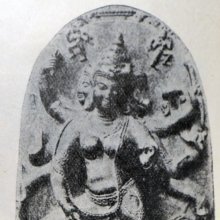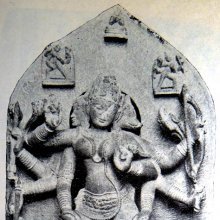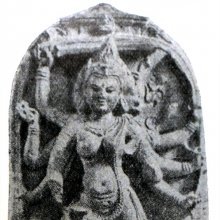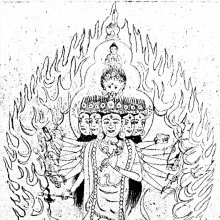Ubhayavarahanana, Ubhayavarāhānana: 1 definition
Introduction:
Ubhayavarahanana means something in Buddhism, Pali. If you want to know the exact meaning, history, etymology or English translation of this term then check out the descriptions on this page. Add your comment or reference to a book if you want to contribute to this summary article.
Images (photo gallery)
In Buddhism
Tibetan Buddhism (Vajrayana or tantric Buddhism)
Source: archive.org: The Indian Buddhist IconographyUbhayavarāhānana (उभयवराहानन) or Ubhayavarāhānanamārīcī is a variety of Mārīcī: one of the various emanations of Vairocana, as mentioned in the 5th-century Sādhanamālā (a collection of sādhana texts that contain detailed instructions for rituals).—Her Āsana is the ālīḍha; her Distinctive mark: two sow-faces; she has three faces and twelve arms.
Ubhayavarāhānana has been given this name because, unlike all other three-faced forms of Mārīcī, both her right and left faces are like that of a sow. She is clad in tiger-skin, has red complexion, a jewelled headdress, a red scarf and is decked in all sorts of ornaments. She resides within the womb of a Caitya, stands in the ālīḍha attitude, and is endowed with three faces, each with three eyes, and twelve arms.
Ubhayavarāhānana faces:—The principal face smiles with delight, is peaceful in expression and display the emotion of love, while the two side ones are distorted sow-like. The face to the left is red, and is paid homage to by a deity carrying the vajra and the mudgara; the face to the right has a reddish effulgence like that of Saindhava salt, and is paid homage to by Purandara (Indra) who carries the vajra and the noose.
Ubhayavarāhānana attributes:—In her six left hands she shows the tarjanī against the chest, the Aśoka bough, the vajrāṅkuśa, the kapāla, the head of Brahmā and the vessel, and in the six right hands the needle, the aṅkuśa, the bhiṇḍipāla ( spear ), the sword, the kartri and the Staff stamped with a vajra. She bears the image of Vairocana on her crown, and tramples under her feet the Hindu gods, such as Hari (Viṣṇu), Hara (Śiva), Hiraṇyagarbha (Brahmā) and others. The guardians of the quarters all pay homage to this goddess.

Tibetan Buddhism includes schools such as Nyingma, Kadampa, Kagyu and Gelug. Their primary canon of literature is divided in two broad categories: The Kangyur, which consists of Buddha’s words, and the Tengyur, which includes commentaries from various sources. Esotericism and tantra techniques (vajrayāna) are collected indepently.
See also (Relevant definitions)
Starts with: Ubhayavarahananamarici.
Full-text: Ubhayavarahananamarici, Marici.
Relevant text
Search found 1 books and stories containing Ubhayavarahanana, Ubhayavarāhānana; (plurals include: Ubhayavarahananas, Ubhayavarāhānanas). You can also click to the full overview containing English textual excerpts. Below are direct links for the most relevant articles:
The Indian Buddhist Iconography (by Benoytosh Bhattachacharyya)



